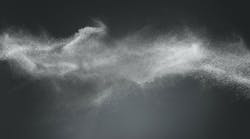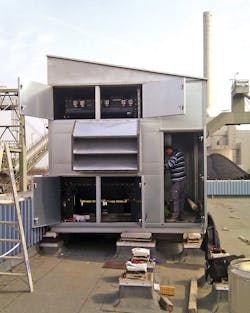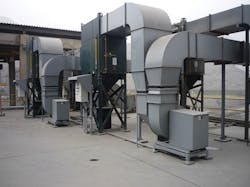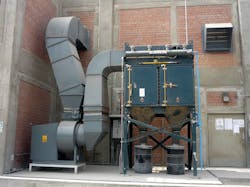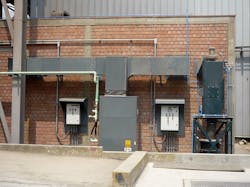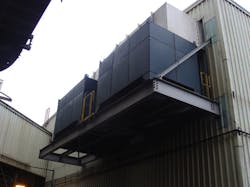High-efficiency dust collectors are best known for maintaining cleanliness in industrial manufacturing spaces. But offices, conference areas, control rooms, server rooms, and similar spaces in these facilities also require protection—against dust infiltration from nearby manufacturing processes and particulate contaminants in outdoor air.
Pressurization in combination with proper air filtration is the most effective approach to this challenge. While high-efficiency HVAC filters are the most common solution, cartridge-type industrial dust collectors are an effective alternative.
Pressurization is a ventilation technique by which a positive or negative atmospheric pressure is maintained in an isolated or semi-isolated environment. It has been used for infectious-disease control by the health-care industry for many years.
A patient with an immunodeficiency disorder typically will be housed in a positive-pressure isolation room, which maintains a flow of air out of the room, protecting the individual from contaminants and pathogens that might enter. Conversely, a patient with a contagious disease will be housed in a negative-pressure isolation room, which maintains a flow of air into the room to keep the disease from spreading to other patients and to health-care workers.
In industrial settings, positive pressure similarly is used to keep particulate or gaseous contaminants out of a room, creating an air barrier between the outside and inside. This makes protecting a space from dirty outdoor air, dust or fumes generated by an adjacent production process, or even excess humidity that seeps in through walls or other openings possible. Offices, laboratories, electrical rooms, and server rooms in industrial facilities are especially prone to dust infiltration, which can create unpleasant or even hazardous working conditions while causing problems with critical equipment, especially electronics.
Conversely, in a pharmaceutical facility where potent compounds are used or in a mining facility where toxic minerals are being processed, negative pressure may be applied—sometimes in conjunction with containment systems—to prevent dust generated in a manufacturing space from cross-contaminating other areas of the plant.
Determining Whether to Pressurize
How do you decide whether pressurization is a good choice for your facility? The decision cannot be based solely on the volume of dust to be controlled. Other factors that must be considered are:
• What or whom you are trying to protect. If a space is unoccupied and/or contains little of value, pressurization may not be worth the expense. But if you are protecting expensive electrical equipment, for a fraction of the cost of the equipment, pressurization will be worth the investment.
Similarly, if dust or fumes reach unhealthy levels in an office area, you will want to keep the area clean to protect occupants and comply with Occupational Safety & Health Administration regulations. Though dirty air long has been known to be hazardous to one’s health, the International Agency for Research on Cancer announced in 2013 that both air pollution and particulate matter would be classified as Group 1 human carcinogens.
• Local climate conditions. In the tropics, if you inject large amounts of warm, moisture-laden outside air to pressurize a building, the additional air-conditioning load could be cost-prohibitive. However, in colder climates or during winter, you can take advantage of the “free cooling” and use your pressurizing system for conditioning, saving substantially on air-conditioning costs required to keep servers and electrical equipment from overheating.
• Anticipated return on investment (ROI). For pressurization to be cost-effective, ROI typically should be less than two years; field experience shows it often is much less.
Pressurization is used in many industries, including cement and lime production, metal and coal mining, pharmaceutical processing, and grain processing. Areas most commonly protected using this technique include control rooms, cleanrooms, compressor rooms, offices, quality-control laboratories, substations, electrical-equipment and motor-control-center rooms, and server rooms.
Pressurization with dust collection can be applied in new construction, an addition or expansion, or a renovation. The retrofitting of air-handling units is possible, but somewhat costly and complex, depending on the setup and location. If you want to replace an air-handling unit with a dust collector, you may encounter the problem of the collector not fitting in the room and/or the roof not being able to support the weight of the equipment. If that is the case, you will have to engineer a solution, which might not be cost-effective.
HVAC Filtration or Dust Collection?
HVAC air handlers used to pressurize non-manufacturing sections of industrial plants may contain ASHRAE-grade or high-efficiency-particulate-air (HEPA) filters capable of capturing very small particulate matter. These filters, however, are not designed for the heavy dust loads generated by some manufacturing processes and may require replacement every few months or even weeks, resulting in high costs.
Cartridge-style dust collectors are designed to handle the high dust loads of industrial environments. When used in a pressurization system, a high-efficiency cartridge filter can go years before needing to be replaced. The main difference between dust collection and HVAC filtration is that a dust collector automatically pulse-cleans its filters using bursts of compressed air that blow dirt off filter surfaces and down into a collection device.
To determine which—dust collection or HVAC filtration—is better for your application, compare:
- The initial cost of the equipment/hardware and the filters.
- The cost of the electrical energy required to operate the system.
- The life expectancy of filters under the anticipated dust-loading conditions. Based on expected changeout frequency, you can arrive at an estimate of annual cost that takes into account not only the price of replacement filters, but labor, equipment downtime, inventory, disposal, etc.
For pharmaceutical- and some food-grade applications, regulations may restrict the types of filters or level of filtration that can be used.
Dust-Collection-Equipment Guidelines
Cartridge-style dust collectors deliver much higher filtration efficiencies and operate at lower pressure drops than baghouses. Because they are located outdoors, they must be equipped with weather-resistant components and controls.
High-efficiency (MERV 15 or 16) nanofiber filter media is the best choice for pressurizing applications. Typically, an outer layer of extra filtration fibers ensures maximum efficiency from Day 1. This allows maximum filtration with low pressure drop.
Do not rely solely on minimum efficiency reporting value (MERV) in choosing filter media. The MERV scale was developed for HVAC filters; it is not accurate for dust collectors in part because it is calculated at different flow rates, takes into account only filter media, and considers only initial efficiency. Emissions performance is a more useful measure. Ask a filter manufacturer to provide a written guarantee of emissions performance expressed in grains per cubic foot of air or milligrams per cubic meter of air.
Go no longer than two to three years between cartridge-filter replacements. Beyond that, a filter may develop a hole or leak and no longer deliver guaranteed efficiency.
For critical applications, HEPA or after-filters, also known as safety monitoring filters, may be installed in ductwork downstream of a collector to provide backup protection in the event of an air leak through the dust-collector filter. In certain cases, HEPA filters will be required to comply with industry-specific regulations. Carbon after-filters often are used for odor control.
A variable-frequency drive (VFD) ensures precise control of dust-collector fan speed, efficiently maintaining desired airflow through the collector. It is a must for pressurized applications and always should be used in tandem with a pressure sensor in the room. The two devices work together to monitor and control pressure.
If you are pressurizing to protect a space from gaseous contaminants, a wet-scrubber system will be needed. If dust is present, however, you still will need a cartridge dust collector installed upstream of the wet scrubber.
Strategies for Air-Conditioned vs. Non-Air-Conditioned Spaces
If a space does not have to be heated or cooled, dust-collector airflow calculations should be based on the ventilation requirement for indoor-air quality plus air leakage through cracks and openings (i.e., standard formulas for infiltration should be used). False ceilings, raised floors, and other construction details may impact the calculations. For suggested velocities across openings and their corresponding pressures, see Table 7-1 of the American Conference of Governmental Industrial Hygienists’ “Industrial Ventilation: A Manual of Recommended Practice.”
If a space to be pressurized requires heating or cooling, dust-collector airflow should average between 10 and 20 percent of HVAC-unit airflow at a given capacity. This approach assumes the HVAC system has been sized to account for infiltration and will ensure you do not overwork the HVAC system by injecting too much humidity. Heavy-duty air-handling components designed to withstand dirty conditions are recommended.
General ventilation guidelines for industrial applications recommend a difference of 5 percent between supply and exhaust airflow. In most cases, a good standard is to set a pressure differential of 0.04 ± 2 in. wg. (For more information, see Section 7.5 of “Industrial Ventilation: A Manual of Recommended Practice.”) Uncontrolled pressure could create high-velocity conditions that result in backdrafts and slamming doors. That is why it is important to use a pressure sensor inside the room to adjust supply air using a VFD on the fan of the pressurizing unit.
For example, to treat an area with office workers using an extraction system mounted on top of the building, you will need a certain number of air changes per hour, which will determine the airflow. Add 5 to 10 percent to that airflow to create pressurization. So, if the goal is to extract 1,000 cfm from a room, the dust collector should be sized with 1,100-cfm capacity to ensure you are injecting more air than you are extracting. If there are any openings or other leak paths, oversize the dust collector slightly, or calculate infiltration and add it to the formula. Again, a VFD and pressure sensor should be used as controls.
A mechanical engineer with expertise in ventilation and dust-collection systems, Pablo Rocasermeno is Camfil APC’s regional manager for Latin America. He can be reached by phone at 800-479-6801 or 870-933-8048 or e-mail at [email protected].
Did you find this article useful? Send comments and suggestions to Executive Editor Scott Arnold at [email protected].









